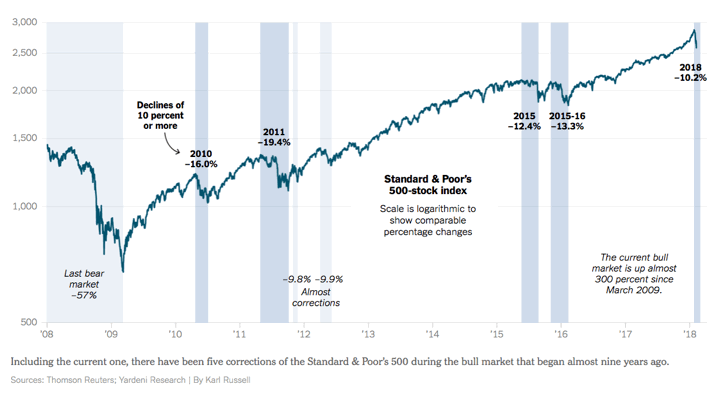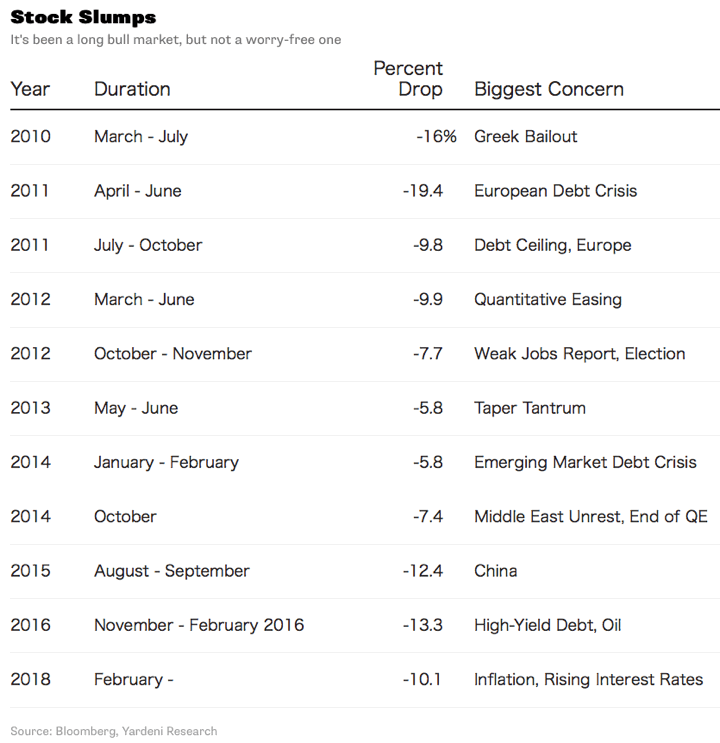The currently-accepted definition of a “market correction” is a price drop of 10% from its peak. There have now been five corrections to the S&P 500 stock index since the bear market of 2009 (seven if you count the 9.8% and 9.9% drops). Here’s a nice visual timeline from the NY Times.

Here’s a corresponding list of all the cited reasons from Bloomberg for the corrections and near-corrections.

If you look at all of those concerns, they all seemed pretty legitimate and scary at the time. The general idea of these articles is that corrections happen regularly, so don’t freak out. Of course, I could also repeat another one of those investing truisms: “A bear market is coming. I’m not saying it’s now… but you know, there will be another bear market in the future.”
This is another item in my big folder of things that are “interesting but not going to change my investment plan”. My plan remains still to buy, hold, rebalance, and keep collecting those dividends and interest payments. David Merkel has a nice summary of how to create a portfolio that allows this hands-off attitude:
[…] my final point is this: size your position in risk assets to the level where you can live with it under bad conditions, and be happy with it under good conditions.
 The Best Credit Card Bonus Offers – 2025
The Best Credit Card Bonus Offers – 2025 Big List of Free Stocks from Brokerage Apps
Big List of Free Stocks from Brokerage Apps Best Interest Rates on Cash - 2025
Best Interest Rates on Cash - 2025 Free Credit Scores x 3 + Free Credit Monitoring
Free Credit Scores x 3 + Free Credit Monitoring Best No Fee 0% APR Balance Transfer Offers
Best No Fee 0% APR Balance Transfer Offers Little-Known Cellular Data Plans That Can Save Big Money
Little-Known Cellular Data Plans That Can Save Big Money How To Haggle Your Cable or Direct TV Bill
How To Haggle Your Cable or Direct TV Bill Big List of Free Consumer Data Reports (Credit, Rent, Work)
Big List of Free Consumer Data Reports (Credit, Rent, Work)
Jonathan, during the previous corrections have you purchased stocks of good companies that were down for no good reason other than being part of the Dow or S&P 500?
In the past I know you have mentioned that you’re against timing the market. However, by purchasing stocks of good companies at lower values my portfolio has skyrocketed once the correction is over.
I compare this strategy to buying quality goods on sale. It’s important that you don’t buy all at once since you don’t know how long a correction will last but on average it is 4 months.
I’m not Jonathan (obviously), but I predict he will say that he does in fact purchase stock of good companies at lower values during dips… as part of index funds that he purchases at regular intervals, regardless (:
I do buy some individual stocks with quality/value strategy, but that is a relatively small part of my portfolio that I don’t spend much time managing. I think buying the entire haystack is a more reliable strategy for the vast majority of my portfolio.
I typically put in very low buys for some of my high quality stocks. I rarely get hits but this last correction I got 3. Sometimes you get lucky.
I’m looking for a way back in.
Hoping for a couple of drops to do so.